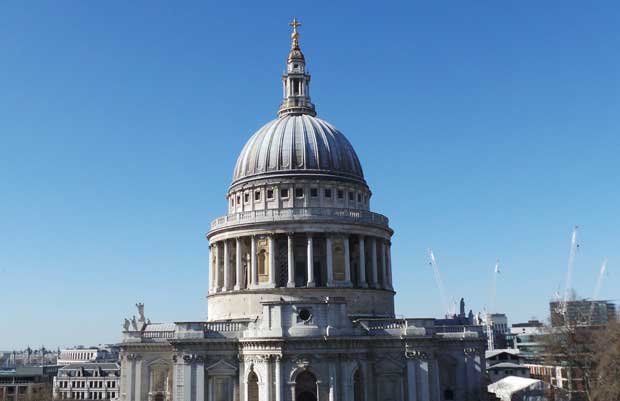
St Paul's Cathedral, is the cathedral church of the diocese of London, the seat of the Bishop of London, and was recently voted the nation's favourite building by the general public of this country.
The present St Paul's (the fifth to stand on the site) was designed by the great British architect Sir Christopher Wren. It took 35 years to build, a relatively short time frame as far as cathedral building is concerned, and, although the whole construction was overseen by one architect, the period of that construction, 1675 - 1710, spanned the reigns of five monarchs.
The west front of St Paul's is one of the most breathtaking views in London. Traditionally the west front is the most ornate part of a church's exterior and the main processional entrance.
If you stand in front of the west front of St Paul's and look up you will see that it is crowned by two clock towers, each of which has a gilded copper pineapple perched on top. However, only one of the towers, the south-west tower, the one on the right, actually has a clock face.
That clock is known as "Big Tom" - 16 feet in diameter and with a minute hand longer than the height of a human being. Housed within the south-west tower are four bells, the two most famous of which are "Great Paul", one of the largest church bells in the country, weighing a whopping 16.5 tonnes, which used to chime an earthy E-flat at 1.00 every afternoon for five minutes. Sadly, due to a defective chiming mechanism "Great Paul" has been mute for the past few years. The other important bell in the south-west tower is known as "Great Tom", which chimes on the hour every hour and also to announce the death of a monarch, a Lord Mayor of London, a Bishop of London, or an Arch Bishop of Canterbury.
The left hand tower contains a further 12 bells.
Between the two clock towers is the pediment - the triangular shaped section resting on top of the upper set of columns.
On top of the pediment is a statue of St Paul, the patron saint of the City of London, the saint to whom this church is dedicated.
It is rather unusual to have a cathedral named after a saint - usually in this country a cathedral takes the name of the city in which it is located.
In the New Testament, St Paul began his life as Saul before his conversion to Christianity on the Road to Damascus, and it is this episode which is depicted in the frieze inside the pediment. The English sculptor Francis Bird carved the frieze and it is an incredibly detailed frieze - you can, for example, make out rooftops of the houses of Damascus on its bottom left hand side. Bird was also responsible for the other statues that adorn the west front as well as the massive font inside the cathedral
Beneath the pediment are two tiers of paired columns, made from a specific type of limestone called Portland Stone,quarried in Dorset in the south-west of England. A remarkable 70,000 tonnes of Portland Stone went into building St Paul’s Cathedral.
St Paul's is a special church in this country for a number of reasons.
It is where many of our most important state occasions have taken place - events such as the Diamond Jubilee of our longest reigning monarch, Queen Victoria in 1897; the State funeral of our great wartime leader Sir Winston Churchill in 1965, the marriage of Prince Charles and Lady Diana Spencer in 1981 and, in 2012, Queen Elizabeth 11 came here for a special service to celebrate her Diamond Jubilee and again to celeberate her 90th beithday in June 2016.
St Paul's is also important because buried here, or memorialised here - and occasionally both - are some of the greatest painters, poets, politicians and military heroes that this country has ever produced, as well as the great Sir Christopher Wren himself.
But, more than anything else, St Paul's is a living, working church and several services a day are held here. These are open to the general public and there is no admission charge to attend a service at St Paul's Cathedral.